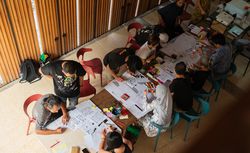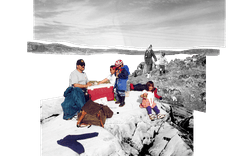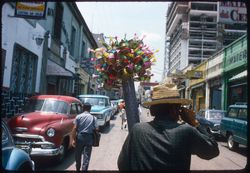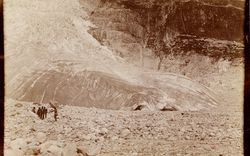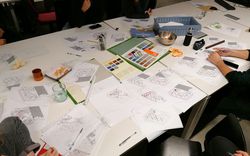In June, Lim will present the results of these workshops and engage with local art communities in Montréal.
Parc Baile, 1920 rue du Fort, CCA
29 August 2024, 6pm
Making Mamak in Montréal
Actions:
Description:
In June, Lim will present the results of these workshops and engage with local art communities in Montréal.
Parc Baile, 1920 rue du Fort, CCA
articles
Futurecasting: Towards Indigenous-Led Architecture
Nicole Luke speaks to Rafico Ruiz and Ella den Elzen about collaboration, collectivity, and listening in the future of Indigenous design
Actions:
Project
AP066.S5.D2
Description:
Le dossier documente une exposition qui s'est tenue au R.C. Harris Water Filtration Plant, Toronto, en Ontario, en 1988, du 22 juin au 30 septembre 1988. L'exposition collective comptait 18 artistes et des architectes et était organisé par le "Visual Arts Ontario". Le dossier contient des dessins, des documents textuels, des documents photographiques et des maquettes. Description de l'exposition: "… individuals were invited to participate in what was billed as 'a prestigious showcase of art, architecture and design which will transform the roof-tops, grounds, and magnificent interiors of the R.C. Harris Water Filtration Plant into a unique museum of contemporary art.' Eighteen artists were invited to participate including John Baldessari, Jonathan Borogsky, Ludger Gerdes, Rebecca Horn, Komar and Melamid, Nancy Sperio, François Girard, Bruce Kuwabara, John Scott, Joanne Tod, Andreas Gehr, Morphosis, Aldo Rossi, Jacques Rousseau, Stacey Spiegel, Team Zoo and Krzyztof Wodiczko." Jennifer Fisher and Beth Seaton,"Waterworks: Visual Arts Ontario", Parachute, nº 52, novembre 1988, p. 59-60. Description du projet: "Parts of the site, …, have provided forms for casting concrete lawn chairs-like shapes - petrified recordings of the topography - fabricated of lake water, beach sand and pebbles, rods and wires." Ibidem
22 juin-30 septembre 1988
Installation "Waterworks", Toronto - "Horizons"
Actions:
AP066.S5.D2
Description:
Le dossier documente une exposition qui s'est tenue au R.C. Harris Water Filtration Plant, Toronto, en Ontario, en 1988, du 22 juin au 30 septembre 1988. L'exposition collective comptait 18 artistes et des architectes et était organisé par le "Visual Arts Ontario". Le dossier contient des dessins, des documents textuels, des documents photographiques et des maquettes. Description de l'exposition: "… individuals were invited to participate in what was billed as 'a prestigious showcase of art, architecture and design which will transform the roof-tops, grounds, and magnificent interiors of the R.C. Harris Water Filtration Plant into a unique museum of contemporary art.' Eighteen artists were invited to participate including John Baldessari, Jonathan Borogsky, Ludger Gerdes, Rebecca Horn, Komar and Melamid, Nancy Sperio, François Girard, Bruce Kuwabara, John Scott, Joanne Tod, Andreas Gehr, Morphosis, Aldo Rossi, Jacques Rousseau, Stacey Spiegel, Team Zoo and Krzyztof Wodiczko." Jennifer Fisher and Beth Seaton,"Waterworks: Visual Arts Ontario", Parachute, nº 52, novembre 1988, p. 59-60. Description du projet: "Parts of the site, …, have provided forms for casting concrete lawn chairs-like shapes - petrified recordings of the topography - fabricated of lake water, beach sand and pebbles, rods and wires." Ibidem
Dossier 2
22 juin-30 septembre 1988
textual records
AP082.S1.018
Description:
Copies of drawings related to the Universal Floor, the Virtual Tower, the Collective Tower, Facades, Cost reduction, etc.
22 January 1999
Universal Building: selected drawings with notes and revisions
Actions:
AP082.S1.018
Description:
Copies of drawings related to the Universal Floor, the Virtual Tower, the Collective Tower, Facades, Cost reduction, etc.
textual records
22 January 1999
The inaugural Architecture as Public Concern Lecture marks the launch of the CCA Research Network, an entity that brings together alumni from almost four decades of research programs at the CCA. This annual lecture extends the theme of the Architecture as Public Concern Fellowship, which asks, in 2023, “Who is the Work For?” It also aligns with the CCA Research Network’s(...)
Online Keyword(s):
Samia Henni, Jay Pather, CCA Research Network, Architecture as Public Concern, communities
26 September 2023, 2pm to 4pm
2023 Architecture as Public Concern Lecture: Who is the Work For?
Actions:
Description:
The inaugural Architecture as Public Concern Lecture marks the launch of the CCA Research Network, an entity that brings together alumni from almost four decades of research programs at the CCA. This annual lecture extends the theme of the Architecture as Public Concern Fellowship, which asks, in 2023, “Who is the Work For?” It also aligns with the CCA Research Network’s(...)
Online Keyword(s):
Samia Henni, Jay Pather, CCA Research Network, Architecture as Public Concern, communities
articles
Oscillanting Spaces, Ludwig Berger, glacier, Morteratsch, Furka, melting, climate change, Alps, Switzerland, sound
18 August 2025
What does a glacier (or climate change) sound like?
On Ludwig Berger’s recordings of melting landscapes
Actions:
works of art
DR1987:0106:001-009
Description:
- A set of eight topographical views of that part of Windsor Great Park and its buildings known collectively as Virginia Water, with an engraved dedication to the Duke of Cumberland.
architecture, landscape architecture, topographic
1754 or 1755
Eight Views of Windsor Great Park
Actions:
DR1987:0106:001-009
Description:
- A set of eight topographical views of that part of Windsor Great Park and its buildings known collectively as Virginia Water, with an engraved dedication to the Duke of Cumberland.
works of art
1754 or 1755
architecture, landscape architecture, topographic
Series
Une architecture des humeurs
AP193.S4
Description:
Series 4, Une architecture des humeurs, 2008-2011, documents the conception and the presentation of exhibition and project Une architecture des humeurs. Presented at Le laboratoire art gallery in Paris between January and May 2010, Une architecture des humeurs is a conceptual, unbuilt, residential urban structure based on a potential future in which contemporary science reads human physiology and chemical balance. The idea is to acquire a chemistry of the “humors”, or the moods and temperament, of future purchasers. Taken as input, the information generates a diversity of habitable morphologies and relationships between them. With this process, the project attempts to make palpable and graspable, through technologies, the emotions of the participants captured via the chemistry of their body. The goal is to gather information on their capacity of adaptation, their level of sympathy and empathy while confronted to a situation or an environment. This information is then analyzed by computational, mathematical, and machinist procedures. This leads to the design and production of an urban structure submitted to the improbable and uncertain protocols produced by emotions, also creating aggregations and layouts that rearticulate the links between the individual and the collective. These structures are calculated following simultaneously incremental and recursive structural optimization protocols resulting in the physicality and morphology of architecture. The layout of the residential units and the structural trajectories are conceived and developed as posterior to the constructs supporting social life and not as an a priori. The structure of each components of the urban structure is generated by a secretion and weaving machine called Viab02. The machine is the second prototype of VIAB which was developed with Robotics Research Lab of the University of Southern California and takes its name from the terms viability and variability. With a process similar to contour crafting, the machine produces bio-cement, a mix between cement and bio-resin, giving form to the adapted residential structures. The records consist largely of images detailing the creative process of the firm, photographs of the exhibition, and 3D models. It also contains animated renderings representing the machine in action and sequences of the construction of the building or the structure. The records include a video orienting the project into François Roche theoretical stance, research as speculation, that can be summarize as the use of technological tools to take a critical and political position through esthetic in order to open new lines of thoughts. AP193.S2 contains updated previous version of the VIAB machine
2008-2011
Une architecture des humeurs
Actions:
AP193.S4
Description:
Series 4, Une architecture des humeurs, 2008-2011, documents the conception and the presentation of exhibition and project Une architecture des humeurs. Presented at Le laboratoire art gallery in Paris between January and May 2010, Une architecture des humeurs is a conceptual, unbuilt, residential urban structure based on a potential future in which contemporary science reads human physiology and chemical balance. The idea is to acquire a chemistry of the “humors”, or the moods and temperament, of future purchasers. Taken as input, the information generates a diversity of habitable morphologies and relationships between them. With this process, the project attempts to make palpable and graspable, through technologies, the emotions of the participants captured via the chemistry of their body. The goal is to gather information on their capacity of adaptation, their level of sympathy and empathy while confronted to a situation or an environment. This information is then analyzed by computational, mathematical, and machinist procedures. This leads to the design and production of an urban structure submitted to the improbable and uncertain protocols produced by emotions, also creating aggregations and layouts that rearticulate the links between the individual and the collective. These structures are calculated following simultaneously incremental and recursive structural optimization protocols resulting in the physicality and morphology of architecture. The layout of the residential units and the structural trajectories are conceived and developed as posterior to the constructs supporting social life and not as an a priori. The structure of each components of the urban structure is generated by a secretion and weaving machine called Viab02. The machine is the second prototype of VIAB which was developed with Robotics Research Lab of the University of Southern California and takes its name from the terms viability and variability. With a process similar to contour crafting, the machine produces bio-cement, a mix between cement and bio-resin, giving form to the adapted residential structures. The records consist largely of images detailing the creative process of the firm, photographs of the exhibition, and 3D models. It also contains animated renderings representing the machine in action and sequences of the construction of the building or the structure. The records include a video orienting the project into François Roche theoretical stance, research as speculation, that can be summarize as the use of technological tools to take a critical and political position through esthetic in order to open new lines of thoughts. AP193.S2 contains updated previous version of the VIAB machine
Series
2008-2011
articles
With and Within
cooperativism, collective, barcelona, spain, la borda, can batlló, social economy, indignados, context
19 April 2021
The Architecture of Cooperation
Kim Courrèges and Felipe de Ferrari of Plan Común speak with Carles Baiges and Cristina Gamboa of Lacol
Actions:
With and Within
